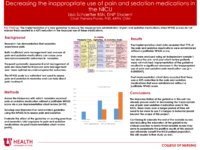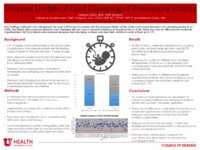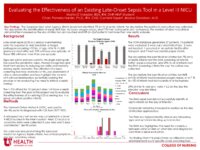The Graduate Nursing Project collection includes Doctor of Nursing Practice (DNP) Scholarly Projects and Master's students' non-thesis projects submitted as part of program requirements.
TO
Filters: Collection: ehsl_gradnu
| Title | Creator | Date | Description | ||
|---|---|---|---|---|---|
| 26 |
 |
Neonatal Golden Hours Project | Thompson, Amy S. | 2020 | Background: Preterm infants are a vulnerable population that require specialized care to achieve optimal outcomes. Preterm infants are at an increased risk of developing sepsis, temperature instability, and hypoglycemia during the first few hours of life. Studies have shown that implementing an ev... |
| 27 |
 |
Optimizing time to treatment for Hypoxic Ischemic Encephalopathy (HIE) for Transported Neonates | DeLaney, Kathryn; Hamilton, Jennifer; Baserga, Mariana; DuPont, Tara | 2021 | Background: Most infants requiring therapeutic hypothermia (TH) therapy for Hypoxic Ischemic Encephalopathy (HIE) are born at facilities without therapeutic capabilities. There is a narrow timeframe for initiating TH, necessitating prompt identification, transport, and initiation of therapy. Quali... |
| 28 |
 |
Optimizing time to treatment for Hypoxic Ischemic Encephalopathy (HIE) for Transported Neonates | DeLaney, Kathryn; Hamilton, Jennifer; Baserga, Mariana; DuPont, Tara | 2021 | Background: Most infants requiring therapeutic hypothermia (TH) therapy for Hypoxic Ischemic Encephalopathy (HIE) are born at facilities without therapeutic capabilities. There is a narrow timeframe for initiating TH, necessitating prompt identification, transport, and initiation of therapy. Quali... |
| 29 |
 |
Placental Lab Draws in the Newborn ICU: A Quality Improvement Project | Evans, Ida Katrina; Hamilton, Jennifer | 2022 | Background: Obtaining an infant's labs from the placenta on admission is a relatively new practice in the Newborn Intensive Care Unit (NICU). This practice decreases phlebotomy losses, reduces blood transfusions, reduces iatrogenic blood loss, and decreases exposure to pain. There is a lack of stand... |
| 30 |
 |
Postpartum Depression: Development and Evaluation of a Screening Workflow Process in the Neonatal Intensive Care Unit | LaBerge, Chloe C.; Anker, Jenn; Hearne, Jenny | 2023 | Background: Postpartum depression (PPD) is the most common complication of childbirth. Typically, screening for PPD is performed in the immediate postpartum period, followed by interval screening at the pediatrician office during well child visits. Within the general population, about 10-15% of moth... |
| 31 |
 |
Prevention of Hypothermia at Delivery in Infants Born Preterm, at 28 to 34 Weeks Gestation, Through Implementation of a Clinical-Workflow Process | Rowley, Denise O. | 2022 | Background: According to the March of Dimes, 10% of infants born nationally in 2021 were born prematurely, at less than 37 weeks. In Utah, 1% of infants are born prematurely each year, between 28 and 34 weeks. Worldwide, hypothermia at delivery occurs at a rate of 30% to 90% among infants delivered ... |
| 32 |
 |
Prioritizing Family-Centered Care in a Level IV NICU:Development and Implementation of a Skin to Skin Care Bundle | Harbison, Lauren | 2022 | Background: Skin to skin care (SSC), also known as kangaroo care, is the practice of placing a mostly undressed infant onto the bare chest of a parent, where they can be held for an extended period. Evidence shows that SSC provides many benefits to infants and their parents, particularly for the hig... |
| 33 |
 |
Quality Improvement Project: The Development of a Feeding Guideline for Neonates with Gastroschisis | Newton, Adriana | 2023 | Background: Gastroschisis is the most common abdominal wall defect treated in the neonatal intensive care unit (NICU). Well-defined standardized gastroschisis guidelines, multidisciplinary team collaboration during guideline development, and sufficient guideline directives regarding feeding progress... |
| 34 |
 |
Standardizing Post-Operative Pain Management in the NICU: A Pilot Study | Birkeland, Angela H. | 2019 | Background: The American Academy of Pediatrics recommends that all institutions have written pain management guidelines to standardize the management of neonatal pain to improve pain management practices and to increase patient safety. Despite the increased awareness and evidence-based recommendatio... |
| 35 |
 |
A Clinical Practice Guideline for the Recognition, Diagnosis and Management of Neonatal Delirium | Schulte, Krista | 2018 | POSTER |
| 36 |
 |
A Consistent Approach to Noninvasive Ventilation in a Level II Nursery | Rushton, Wendy A. | 2017 | POSTER |
| 37 |
 |
A Post-Operative Pain Management Guideline for Opioid Exposed Neonates | Pabst, Erin; Rigby, Marilyn; Ling, Con Lee; Birkeland, Angie | 2020 | POSTER |
| 38 |
 |
An Improved Hearing Screening Protocol for the Most Vulnerable Infants | Blatt, McKenzie; Johnson, Adrienne; Hamilton, Jennifer L. | 2021 | POSTER |
| 39 |
 |
Are Placental Blood Samples a Proxy for Infant Blood Samples When Comparing Lab | Vance, McKenna; Christensen, Robert; Phares, Pamela | 2020 | POSTER |
| 40 |
 |
The Creation and Implementation of a Neonatal Palliative Care Toolkit | Warren, Charise; Bierer, Ryan; Hamilton, Jennifer | 2023 | POSTER |
| 41 |
 |
De-implementing the Routine Measurement of Gastric Residual Volumes in an All-Referral Newborn Intensive Care Unit | Tucker, Erin B. | 2023 | POSTER |
| 42 |
 |
Decreasing the Inappropriate Use of Pain and Sedation Medications in a Level III NICU | Schaeffer, Lisa; Phares, Pamela | 2020 | POSTER |
| 43 |
 |
Delayed Umbilical Cord Clamping of Premature Infants | Orton, Melissa; Schiefelbein, Julieanne; Chan, Belinda | 2021 | POSTER |
| 44 |
 |
Development of Neurocritical eLearning Modules for NICU Nurses & Neonatal Nurse Practitioners | Hearne, Jennifer | 2019 | POSTER |
| 45 |
 |
Education on Appropriate Infant Positioning In the NICU | Bodamer, Peggy | 2020 | POSTER |
| 46 |
 |
Efficacy and Risks of Milrinone in Congenital Diaphragmatic Hernia Neonates | Mears, Michelle | 2018 | POSTER |
| 47 |
 |
End-of-life self-efficacy initiative in the NICU | Trimm, M. Rhiannon | 2022 | POSTER |
| 48 |
 |
Establishing Earlier Full Enteral Feedings in the Hospitalized Neonate | Hamilton, Jennifer; Konana, Olive | 2021 | POSTER |
| 49 |
 |
Evaluating the Effectiveness of an Existing Late-Onset Sepsis Tool in a Level III NICU | Valadez, Marta G.; Hardin, Pamela | 2022 | POSTER |
| 50 |
 |
Evaluation of the Neonatal Nurse Practitioner Role in a Level II Nursery | Seeholzer, Hanna; Rigby, Marilyn; Hoggan, Tricia | 2021 | POSTER |
